A-3in order to produce this crater, a charge with at least 70 megaton of TNT of explosive powerneeded to be used.Around the Tapanui Crater local Maori names take a meaningful content. After beingtranslated, these names provide a fascinating description of a powerful explosion, whosecourse coincides with the content of the legend on the Fires of Tamaatea. To supplementthose explained before, a few more examples of similar names follows: HA-KA-TARA-MEA= the fire ignited by the breath of a horn-shaped-object (spaceship), TA-PA-NUI = the hugeexplosion, TO-KA-NUI = the fall of huge fire, WAI-KAKA = the area red from heat.The Tapanui Crater itself is also very unusual. It displays a number of attributes, allof which indicate its origin from a powerful magnetic explosion. Listed below are the mostevidential of them. (1) Its shape is a mirror reflection of the area of flattened trees as inTunguska, Central Siberia - see Figure C6. (2) The main axis of the Crater coincides withthe course of a local magnetic meridian in the year 1178. (3) Everything within it isturbulently magnetised. (4) Apart from a turbulent magnetic field, within the Crater anunknown telekinetic-type field is active which at random plays tricks on technical equipment;stopping car engines, obstructing the operation of TV and photographic cameras, spinningdowsing rods and pendulums, and more. (5) Wild animals seem to avoid the Crater (e.g. itsvicinity is plagued with rabbits, but the author has not seen a rabbit within its boundaries,wild birds change the direction of flights when approaching the Crater, etc.). (6) The bottomof the Crater is covered with a layer of charcoal and scorched wood, although the firstsettlers have not noted any forests in its vicinity. (7) The internal topography of the Cratersuggests its origin from a series of about seven explosions. (8) The hill slope near theCrater's eastern edge is covered with a layer of silicone sand that originates from thebottom of the Crater (in order for this sand to get there, it needed to be splashed up-hill). (9)Within the Crater, and around it, magnetized ceramic stones (locally called "china stones"because their properties resemble those of lumps of porcelain) are piled, sometimes havingsmoke and wood-splinters melted into their surface.After the Tapanui Crater was located, further investigations were expedited. By theend of 1988, a wealth of material evidence confirming the origin of the Crater from theexplosion of a cigar-shaped stack of seven Magnocraft-type vehicles, was identified andthoroughly documented. Apart from this discussed already, the evidence includes:1. The historic lack of forests in areas of the South Island which surround theTapanui Crater, in spite of the local climatic conditions which stimulate the growth of foreststhere, and in spite of charred remains of totara trees spread in these areas. The carbondating of these remains indicates their destruction around 1178.2. The (non-accidental) radial order in the positioning of old tree trunks still lyingaround the Tapanui Crater. They are parallel to each other and their trunks are pointing atthe Tapanui Crater. The roots are always turned towards the crater site.3. The evidence of mass extinction of the Moa bird around 1178. This huge bird,whose height sometimes reached 4 metres, before the Tapanui explosion was flourishing inlarge numbers in the South Island. However, it did not survive the explosion, the resultantcolder climate, and the years of Maori hunger to follow. It is of interest to note that largenumbers of scorched remains of Moa bird are placed from the Tapanui side of variouswater reservoirs. This looks as if flocks of these non-swimming birds were trying to escapefrom something horrifying approaching them from the Tapanui direction, but they weretrapped on the edges of water reservoirs where the destruction finally got them.4. The deficiency of some micro-elements (e.g. selenium, iodine) in the soil aroundthe Tapanui Crater. The elimination of these elements could be a consequence of theexplosion and the subsequent long-term exposure to local magnetic anomalies.5. A noticeably higher (in relation to the population) number of cases of a mysteriousillness called "Tapanui flu" amongst locals. (The medical name for the Tapanui flu is:Myalgic Encephalomyelitis, or ME syndrome.) This illness manifests itself through an
A-4immune deficiency, thus it is quite similar to radiation sickness. A similar illness was alsoregistered within the range of the Tunguska explosion.6. The splash, radiating from the Crater, of unusual ceramic stones called "chinastones" - see Figure C13, The interesting attribute of china stones is that some of themcontain organic matter, e.g. leaves, wood-splinters, and in one case also a fish.7. The presence of a rare mineral called "trinitite" (known deposits of this mineralmainly originate from nuclear explosions or from Tunguska).8. Magnetized metal pieces, sometimes looking like parts of instruments, which canbe found within the range of post-explosion falls - see Figures C14 and C15.9. Surface gold deposits discovered around the Tapanui Crater. According toliterature concerning craters, the direct consequence of shockwaves and vibrationsaccompanying large-scale explosions is that it uplifts to the surface heavy minerals whichare originally located deeply underground.10. The atmospheric anomalies that appear around the Tapanui Crater. Frequentlytornados (which in other parts of the South Island are almost unknown) are born there. Alsorapid local fogs, electrically charged winds, and many other unusual phenomena are noted.It is interesting that all these can be explained by magnetic anomalies imprinted into theground by the explosion.11. There is one extremely mysterious phenomenon reported to repeatedly occur in,and around, this Crater, which could be qualified as a totally new electro-magneticmanifestation, unknown so-far to science. It takes the form of small, perfectly round spheresof white light, that appear at darkness (around midnight), glow intensively and fly in an"intelligent" manner. All these spheres seem to have the same diameter, equalapproximately that of ping-pong balls. There were observed on numerous occasions by theowner of the Tapanui Crater, by his daughter, and by a group of brave healers whointended to experiment with spending a few nights camping in the Crater (these smallspheres actually made them abandon their experiment after the first night).12. The Crater is a centre of intensive UFO activity. The large number of visualobservations of these vehicles is supplemented there by numerous scorch circles (similar tothe "Crop Circles" which some time ago gained fame in England) left in former landing sitesof UFOs - see Figure G9. It appears as if pilots of these vehicles keep returning to view theplace where colleagues died so spectacularly and to monitor long-term consequences ofthe explosion.The Tapanui explosion was so powerful that its reflection from the moon wasobserved as far as England by a group of monks from Canterbury Cathedral. The historicrecord of this observation, made by brother Gervase - a Chronicler of the CanterburyCathedral, is dated on the evening of 18 June 1178 (in New Zealand it was the morning of19 June). This record is quoted in the book by Simon Welfare & John Fairley: "Arthur C.Clarke's Mysterious World", William Collins Ltd., London 1980, ISBN 0-00-216536-8, page184. Approximately 810 years later it has allowed for the precise determination of the dateand hour when the Tapanui explosion took place.The consequences of the Tapanui explosion can be observed not only in NewZealand, but throughout the entire globe. One of the researchers whose findings supportthe author's hypothesis about the global impact of this event, is a New Zealand botanistnamed John T. Holloway. In his treatise "Forests and Climate in the South Island of NewZealand" (Technical Paper No. 3, Forest Research Institute, New Zealand Forest Service,September 1954) he completed an in-depth analysis of the New Zealand climate arriving atthe final conclusion that around the time of "Fires of Tamaatea" there was a rapid andsignificant climate change extending not only to this country. To reinforce this conclusion hepresents the evidence that before 12th century the South Island of New Zealand wascovered with totara bush, and also that kumara (sweet potato) were cultivated there, bothcurrently thrive only in the upper part of the North Island. The unexplained and significantcooling of New Zealand that occurred around 1200, Holloway links with the global climatic
- Page 1 and 2: Proof Copy ([5e/3] reformatted to P
- Page 3 and 4: 3G-83 G. Evidence certifying that M
- Page 5 and 6: 5Notes:(1) Before this monograph wa
- Page 7: A-2or disk"). The information which
- Page 11 and 12: A-6edition, 1986) even tries to arg
- Page 13 and 14: A-8changes have no connection with
- Page 15 and 16: A-10Fig. A2. The curved slope in th
- Page 17 and 18: B-12inspired me to suspect that hum
- Page 19 and 20: B-14Earth by evil UFOnauts God trie
- Page 21 and 22: C-16#10. The spread, radiating from
- Page 23 and 24: C-18"Te Ura-a-Te Raki-Tamau", which
- Page 25 and 26: C-20item #2 that follows). Thus, in
- Page 27 and 28: C-22comparative data which reflects
- Page 29 and 30: C-24exploding fires, columns of fir
- Page 31 and 32: C-26banks of the Black Gully Creek,
- Page 33 and 34: C-28meditating, conducting healing
- Page 35 and 36: C-30deaths of people with symptoms
- Page 37 and 38: C-32(1) The Kawakawa volcano erupte
- Page 39 and 40: C-34The Tapanui Crater is the centr
- Page 41 and 42: C-36Fig. C2. The inner topography o
- Page 43 and 44: C-38(a)(d)(b)(c)(e)Fig. C4. Example
- Page 45 and 46: C-40Fig. C6. The illustration of si
- Page 47 and 48: C-42Fig. C8. The distribution of in
- Page 49 and 50: C-44Fig. C10. Two photographs of a
- Page 51 and 52: C-46Fig. C12. The location of near-
- Page 53 and 54: C-48Fig. C14. A magnetized metallic
- Page 55 and 56: D-50Chapter D:EVIDENCE THAT THE TAP
- Page 57 and 58: D-52including Mediterranean and Biz
- Page 59 and 60:
D-54rapidly released by this explos
- Page 61 and 62:
D-56experiments, and many more. Thi
- Page 63 and 64:
D-58that people were in medieval ti
- Page 65 and 66:
D-60then continually resonates in t
- Page 67 and 68:
D-62"tapanui.htm") are to be met, s
- Page 69 and 70:
D-64when such abnormalities of the
- Page 71 and 72:
E-66Chapter E.HYPOTHESES EXPLAINING
- Page 73 and 74:
E-68is directed towards the magneti
- Page 75 and 76:
F-70publication of this design and
- Page 77 and 78:
F-72can be built, each type taking
- Page 79 and 80:
F-74sites an explosive growth of mu
- Page 81 and 82:
F-76F4. Explosion sites of the Magn
- Page 83 and 84:
F-78- Deficiency of some sensitive
- Page 85 and 86:
F-80(a)…(b)…(c)Fig. F2. The des
- Page 87 and 88:
F-82Fig. F4. The explanation for a
- Page 89 and 90:
G-84The formal proof that "UFOs are
- Page 91 and 92:
G-86civilization(s) sending UFOs mu
- Page 93 and 94:
G-88the close proximity of the Tapa
- Page 95 and 96:
G-90(c)(d)Fig. G1. Two photographs
- Page 97 and 98:
G-92(a)(c)(b)(d)(e)Fig. G3. A spher
- Page 99 and 100:
G-94(a)(b)(c)(d)Fig. G5. Pulsating
- Page 101 and 102:
G-96(a)(b)(c)(d)(e)Fig. G7. Smooth,
- Page 103 and 104:
G-98(a)(b)(c)(d)Fig. G9. Photograph
- Page 105 and 106:
H-100#6. The Tapanui Crater is orie
- Page 107 and 108:
I-102Chapter I:MORAL ACCENTUATION O
- Page 109 and 110:
J-104explosion energy carrier would
- Page 111 and 112:
J-106detonation a number of appropr
- Page 113 and 114:
J-108resembled "china stones" from
- Page 115 and 116:
K-110Chapter K:AROUND 13 500 YEARS-
- Page 117 and 118:
K-112civilisation were prepared for
- Page 119 and 120:
L-114Chapter L:STILL ANOTHER UFO EX
- Page 121 and 122:
L-116Coincidentally, the author had
- Page 123 and 124:
M-118in section D3). This in turn h
- Page 125 and 126:
N-120Chapter N:TWELVE TRUTHS ABOUT
- Page 127 and 128:
N-122only factors which may cause t
- Page 129 and 130:
N-124ones who stand by truth and th
- Page 131 and 132:
O-126Chapter O:ACADEMIC ASPECTS OF
- Page 133 and 134:
O-128Galactic field, thus producing
- Page 135 and 136:
O-130specifically what was wrong wi
- Page 137 and 138:
O-132moral field causes that we acc
- Page 139 and 140:
O-134white glowing balls of playful
- Page 141 and 142:
O-136brought disgrace to that unive
- Page 143 and 144:
O-138the Polish language only, whic
- Page 145 and 146:
O-140occupation of Earth, and then
- Page 147 and 148:
O-142in a few years of time, when t
- Page 149 and 150:
O-144and both these matters were se
- Page 151 and 152:
O-146today. We need to realize this
- Page 153 and 154:
O-148Of course, the above history i
- Page 155 and 156:
O-150two kinds of resource publicat
- Page 157 and 158:
R-152Chapter R:AT THE END OF THIS M
- Page 159 and 160:
R-154forget that such paid scientis
- Page 161 and 162:
S-156Chapter S:REFERENCES COMPLEMEN
- Page 163 and 164:
S-158[7/2] Giordano D. and Pajak J.
- Page 165 and 166:
T-160Magnocraft exploded over New Z
- Page 167 and 168:
Z-162Appendix Z:Directions for gett
- Page 169:
Z-164Fig. Z1. The most educational



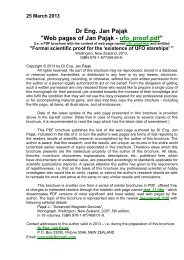


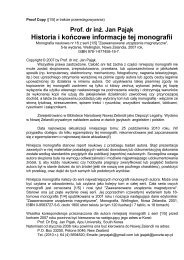
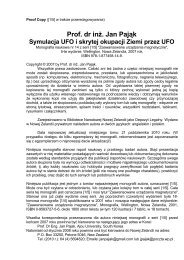
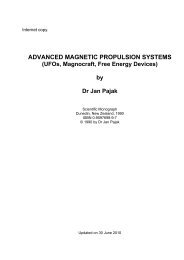
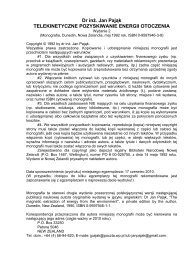
![[1/4p]: PDF - Totalizm](https://img.yumpu.com/45003232/1/184x260/1-4p-pdf-totalizm.jpg?quality=85)
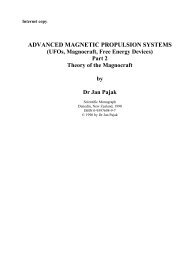
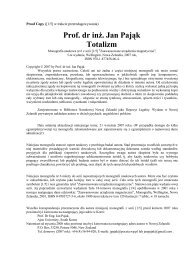
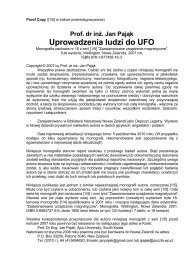
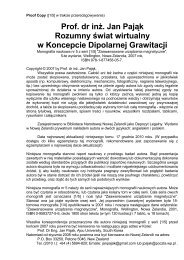
![[1/4p]: PDF - Totalizm](https://img.yumpu.com/39351336/1/184x260/1-4p-pdf-totalizm.jpg?quality=85)
